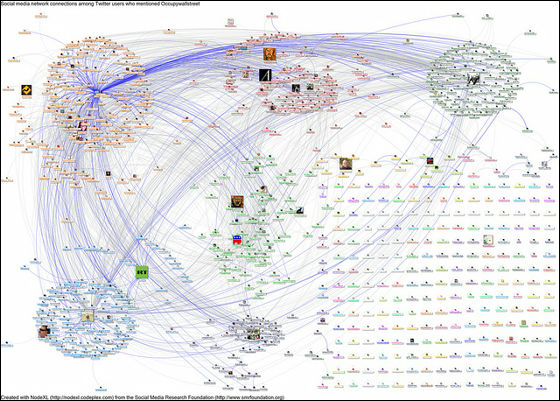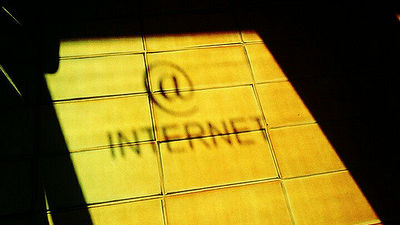What is the backbone structure supporting the Internet and the trend of the cost structure between areas

ByBen
The Internet which we usually use casually and feel close to is also the foundation of the network communication by cable and wireless all over the world if you follow that flow. Placing data centers around the worldContent delivery network(CDN) services are offeredCloudFlareI will explain about the mechanism of backbone connection that supports such Internet and the trend of the fee structure seen for each area of the world by blog.
The Relative Cost of Bandwidth Around the World | CloudFlare Blog
http://blog.cloudflare.com/the-relative-cost-of-bandwidth-around-the-world
◆ Fee structure of internet line
The Internet is a huge network of countless small networks gathered. There are roughly two types of connection method for each network, "peering connection" (Peering) state where the networks are directly connected to each other, "transit connection" (Transit) in the middle through the other network, I call it.
Most of the connection of the Internet is made by transit connection, but there are only 10 companies in the world that are responsible for communication between areas on the most basic part of internet communicationTier 1It is a provider called NTT Communications in Japan, and it is the only provider that has been certified as Tier 1 in Asia. In addition, "Tier" is also a term meaning "subcontracting", and in the manufacturing industry etc., we call the first subcontract and the second subcontract as "Tier 1, Tier 2".

ByMarc Smith
CloudFlare, which places data centers around the world, purchases line widths from either Tier 1 or the transit provider depending on the area's situation. The contract is a system that is charged on the basis of the "capacity" used for each month, and unlike Amazon Web Service and conventional CDN which are charged on a monthly basis on the amount of transfer used, a certain period It is said that it is charged according to the maximum value of the bandwidth used for.
The following figure shows the transfer amount in CloudFlare's global network in a graph. It is color coded for each data center existing in 28 places in the world.

Of contracts for each provider, in almost all contracts, out of the monthly results95 th percentileThe claim is made based on the value of. "95th percentile" means to list all the numerical values over a certain period of time and take a value of 95% from the lesser one. Conversely, the value of the top 5% will be truncated and within the time equivalent to 36% of 5% of the month (= 720 hours), no matter how much usage is used it will not be reflected in the fee That means that. In the episode that has turned into an urban legend, the earliest Google uses this mechanism, and in monthly contracts it reduces the bandwidth and reduces the usage fee, and the "search index" that actually consumes the transfer amount It is reported that using a method of completing transmission and reception at once in a short period of 24 hours per month, was suppressed communication charges.
Also, the contract with the transit provider is characterized in that fees often occur only in the bandwidth of either ingress or sending (egress). CloudFlare which is a CDN service is a proxy service that performs caching, so the transmission (egress) exceeds the reception (ingress), and the difference has reached 4 to 5 times. The merit of this state is, for the serverDoS attackIs done and even when a large amount of data is sent, it does not exceed the bandwidth of egress side, so there is no point that unnecessary fee will not occur.
◆ Peering
While there is a way to pay a transit provider that transfers via transfer as described above, you can also use the "PeeringIn general, it is common that charges do not occur according to traffic volume. In other words, if you increase the connection by peering and decrease the transfer amount of the transit contract, you will reduce the cost of using the meter, so CloudFlare is also working on peering building as shown in the graph below.

It also leads to reduction of latency (data latency) by not passing through providers that exist in the middle, and in general peering has many merits. The following graph shows the ratio of peering connection (light blue) and transit connection (blue) in CloudFlare, showing that the ratio of peering connections reaching approximately 3000 has increased to about 40% of the total It is.

◆ The situation in each area of the world
Based on the above, CloudFlare shows the current status of each area based on the results at the data centers existing all over the world, and we mainly compare in terms of cost. In comparison, based on the transit provider fee in North America, "per 1 Mbps transfer$ 10(Approx. 1000 yen) "and compare it with the fee of each area. There are no data in Russia, China, India and Africa where data centers do not exist.
·north america
Although it is the ratio of peering which reaches 40% at the world level, it is only 20% in the North America area. This is one of the reasons why transit charges in North America are within the world's lowest level. If the peering ratio is 20%, the overall cost unit price per 1 Mbps$ 8(About 800 yen), which means that it is the second lowest unit price in the company.

·Europe
Because the transit fee in the Europe region is almost the same as that in North America, the standard cost per 1 Mbps is set at 10 dollars per 1 Mbps as in North America. However, as you can see clearly from the graph below, in Europe the proportion of peering connections has increased remarkably. Thanks to the peering rate reaching approximately 50%, the cost per unit cost in Europe is per 1 Mbps$ 5(About 500 yen), which is the lowest level among the company.

The factor that increased peering in Europe is that there is an organization that carries out "Peering Exchanges" unique to this area. This is a mechanism that each network shares a communication line in common, it is possible to reduce the cost because each network can share the cost, and also because the management organization is a non-profit organization, use hurdles are lowered It is supposed to be.
·Asia
Since the peering situation in Asia is almost the same level as Europe, a low cost structure can be imagined, but in reality the cost of transit connection is jumping up and as a result the overall cost increases It is said that. The standard cost per 1 Mbps is about 70 dollars (about 7000 yen), which is seven times higher than that of North America. By subtracting about 50%, which is the ratio of peering connections, to this, cost per unit cost in Asia per 1 Mbps$ 35(Approx. 3500 yen), which means that it is about 4 times as much as the unit price in North America.

Although there are various factors in this high cost structure, it is said that there are two main factors in roughly divided. One is that there are few companies offering services, so the level of competition between services is low. And the other point is that the cost necessary for building and maintaining the optical fiber communication network which crosses the Pacific mainly influences the price.
·latin america
Latin America generally refers to Central and South American and Caribbean islands, including Mexico. The area is said to be the most recently expanded area for CloudFlare, and the fact that the development of the net network was not so well set up at the point where the first data center was opened, and transit connection was the only way to connect .
After that, the ratio of peering connections increased in earnest when establishing the service system in Brazil, which is the largest data consumption area in Latin America, and Colombia. It is said that the ratio is about 60%, which is the highest peering rate at the company. The standard cost per 1 Mbps is 80 dollars (about 8000 yen), and when the peering rate of about 60% is subtracted, the cost unit cost in the Latin America region per 1 Mbps$ 32(About 3200 yen) and it turned out that it is almost the same as the Asian region.

·Australia
The area is said to be the region with the highest cost unit price among the company. The standard cost per 1 Mbps is 200 dollars (about 20,000 yen), and even if deducting about 50% of the peering rate, the cost unit price per 1 Mbps$ 100(About ten thousand yen) has become a different thing.

The cause of this high cost is providing transit connection services in AustraliaTelstraIt is said that the cause is the most. According to Telstra that the share in the country reaches approximately 50%, the use fee is jumping because it sets a very high fee, and Australia has a population of 750 million in Europe Despite the fact that there are only 22 million people and only 3%, the fact that the costs paid monthly are almost identical highlights the specificity.
◆ Summary
The table below summarizes cost per unit cost for each region and it turned out that it is about 6 times wider in Asia and Latin America and 20 times more in Australia than in Europe with the lowest cost. Although it is necessary to add some geographical factors to some extent, it is also interesting that there is a part that can not be explained by itself.

In addition, CloudFlare said that it is continuing its efforts to realize the same price worldwide, and that it is exploring ways to reduce costs through all routes.
Related Posts:
in Web Service, Posted by darkhorse_log







